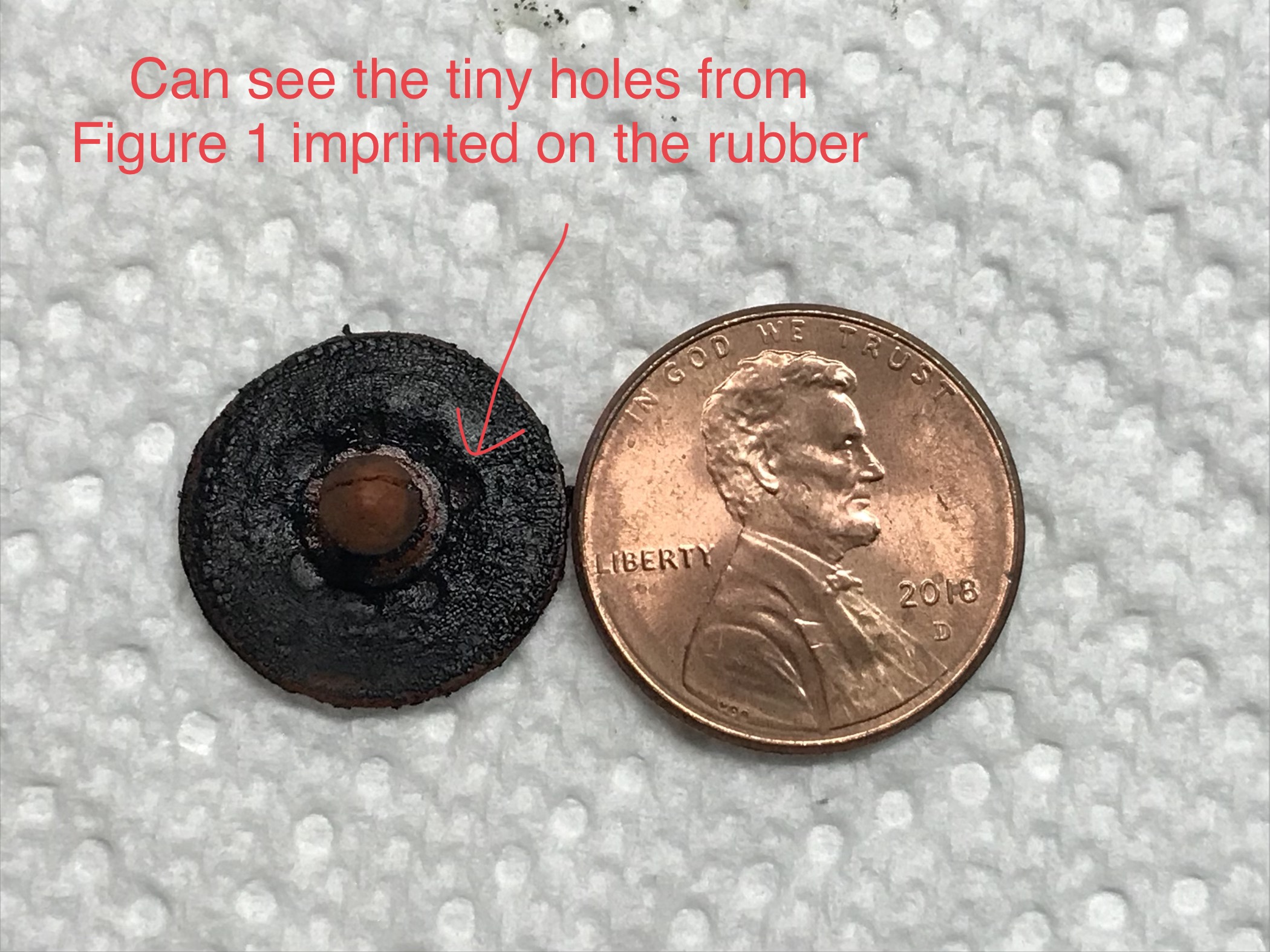Pirate Luke
Member
Reason for writing this:
I bought a brand new sonic 1.4L turbo in 2013 and over the last 5 years/100k miles I developed oil residue inside my intake manifold to the point it caused all kinds of minor issues (which I didn’t realize at the time) with my car. The most upfront and noticeable issue I wanted to diagnose was a rough idle while stopped. In googling and researching my issues I ended up on a few PCV related threads, with a great one on CruzeTalk and one here on SOF by our own Preloader.
BUT, scattered throughout the forums are PCV related questions/issues that either don’t get the answer or get a veteran forum member that mentions checking the intake manifold check valve issue and the new user who just joined for help has no clue what they are talking about, although a starting point. I realized there is a major lack of a “Hey new sonic user, be aware of this PCV issue with your car” thread anywhere obvious here on SOF. So my goal here is to centralize this information for both SOF members and readers who end up here from researching their own issues, and also provide a place for discussion.
1.4L PCV system explained:
I’ll start with the obvious. PCV stands for Positive Crankcase Ventilation. An excellent breakdown on what that is and how it relates to our particular engine can be found in Preloaders thread here: http://www.sonicownersforum.com/forum/1-4l-turbo-sonic-engine-discussion/10825-1-4t-pcv-explained.html. The important thing to take away from that thread is that our 1.4L turbo engines have a closed loop PCV system with two paths:
1) A path when the engine is at idle/vacuum
2) A path for when the system is WOT/utilizing the turbo(boost)
In Figure 1 below you are looking at a close up of this problematic check valve inside the intake manifold which has a 11/32” nut next to it for scale. When entering path two it also passes a second less problematic check valve at the turbo inlet.
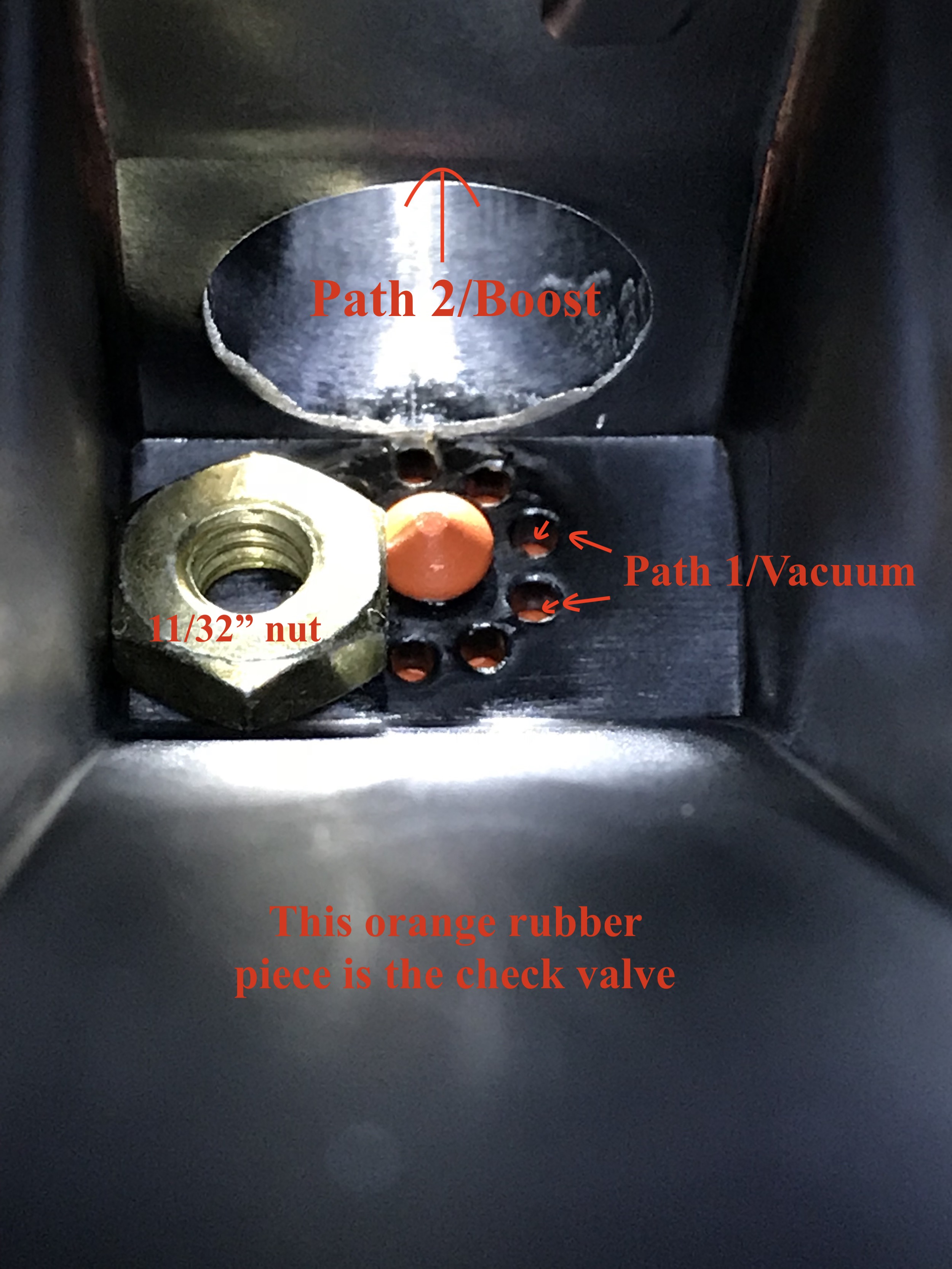
Figure 1
At idle PCV gases flow through the tiny holes at the orange check valve, and at WOT that check valve snaps shut and the gases travel up through the hole above which goes to the turbo inlet.
PCV check valve disappearing:
Now that we understand how that check valve is intended to operate we can get into the problems people are experiencing with it. The most prevalent issue is the orange rubber check valve dislodges and gets burned up in the engine, which usually causes the valve cover to fail as well due to the now unmetered pressures through that hole and the car throws under-boost codes and runs like dirt. To verify your check valve is there, it’s as simple as removing the metal retainer on the hose in Figure 2 below and lifting up (located right behind the engine cover on top center of the intake manifold). Looking down that hole is looking down the hole labeled “Path 2/Boost” in Figure 1. You should see the orange nipple of the check valve if it’s still there.
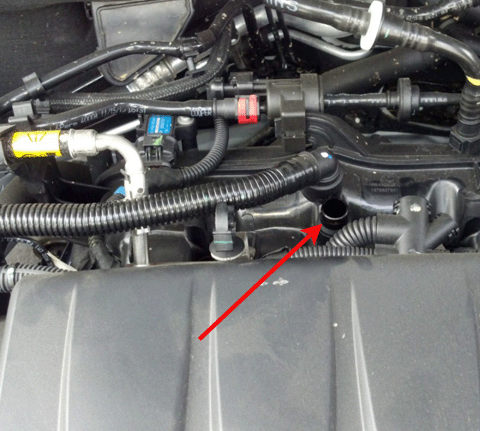
Figure 2
If you don’t see anything it could be dirty, which we’ll get to shortly. If it’s gone you’ll need to replace the whole intake manifold or perform a mod to add an external check valve. A perfect guide on removing the intake manifold can be found here: How-To: Remove 2011-2016 Cruze 1.4L Intake Manifold. Boost on stock vehicles can reach upwards of 13-16 psi. In the instance you completely close the throttle while at that level of psi your engine has a massive shift from positive/boost pressure to negative/vacuum pressure right at that check valve as it opens up, sometimes sucking the whole check valve with it. That’s why tuned engines that run higher boost levels (~20 psi) have a higher chance of this occurring.
PCV check valve getting clogged/dirty:
Now we get to the issue that I’ve personally experienced which can be extremely difficult to diagnose depending on how many miles you get out of your intake manifold’s check valve and how clear it may or may not be to visually see the gunky mess within it. Essentially, with the huge shift in pressures previously mentioned, oil vapors come with it occasionally. Here is what that looks like on my application that made it to 100k miles before causing issues:
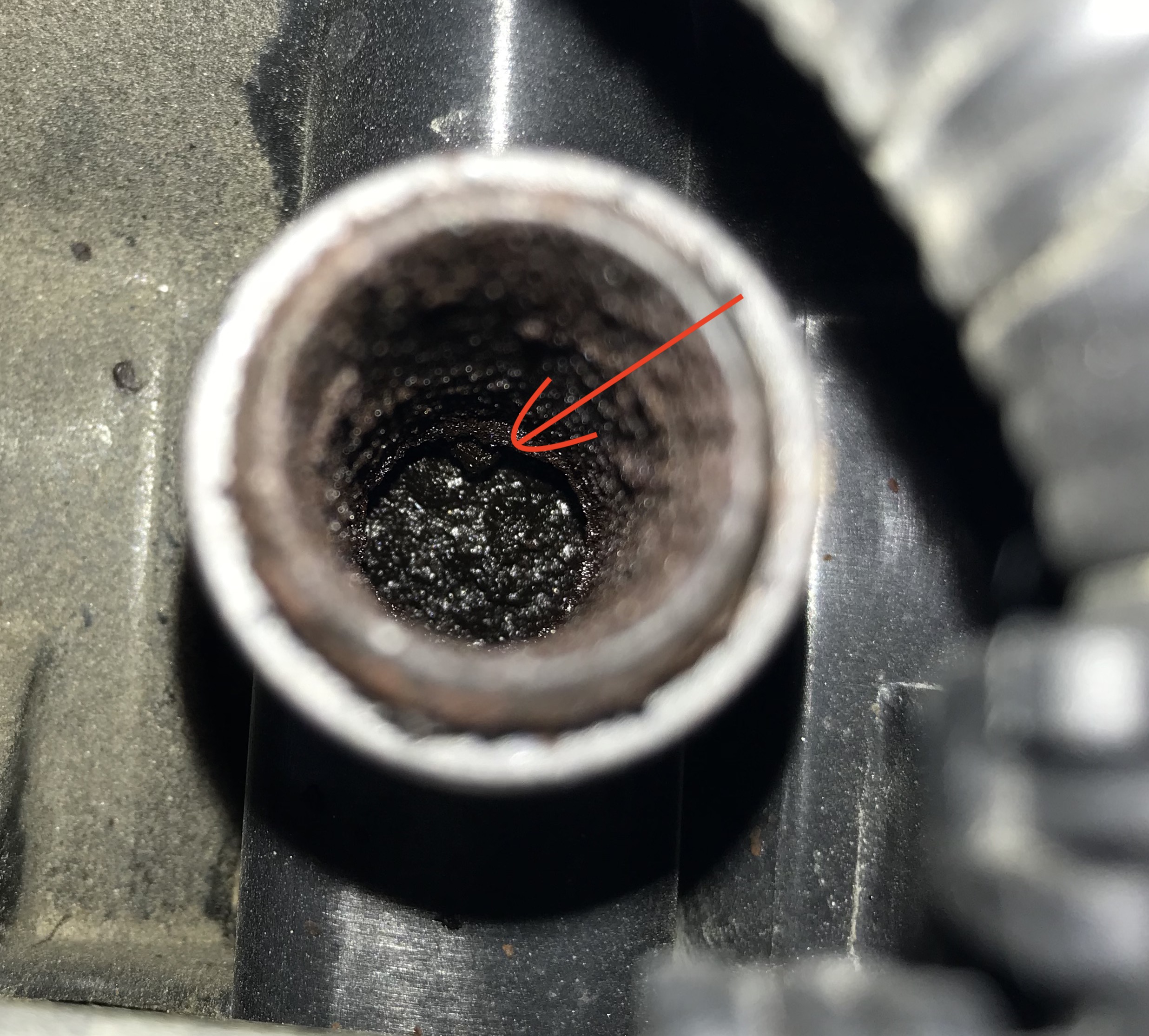
Figure 3
As you can see by simply looking down the hole I mentioned in Figure 2, I could see my check valve was extremely caked in oil residue from 5 years/100k miles of use. Honestly, before I started having issues with it I had no reason to check it. Knowing this now, I’ll be cleaning the holes with a Q-tip/rubbing alcohol every oil change, as it only takes 60 seconds to do.
Now although it was clear that particular portion of the intake manifold was pretty dirty, I cleaned the holes of the check valve without resolution to my rough idle. Looking at Figure 4 below you’ll see just how caked the entire PCV runner had gotten:
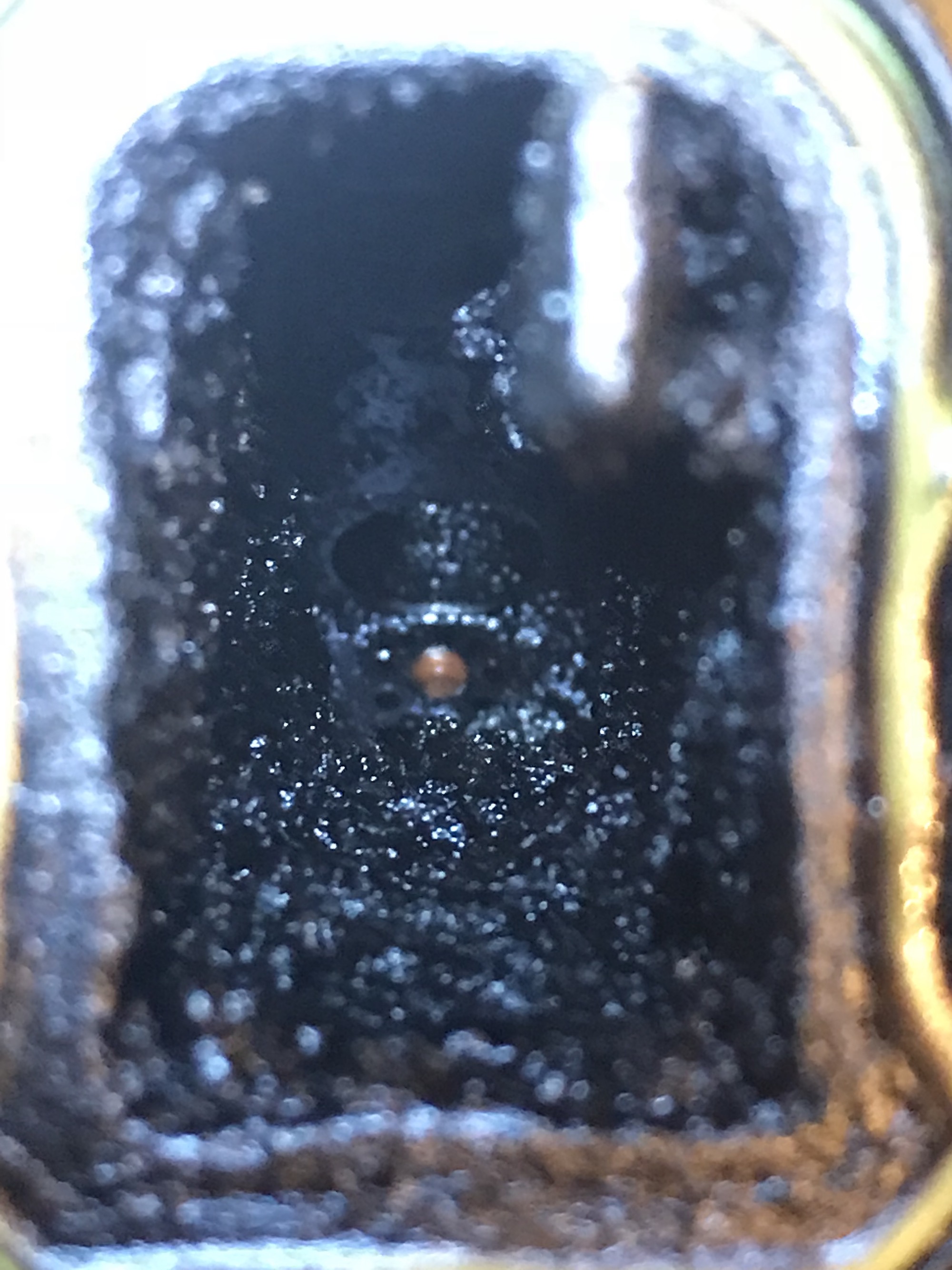
Figure 4
Clearly, there was just far too much gunk in there. I figured once the holes were uncovered the vacuum would return to normal, and it did to an extent, but was still bad enough that it really just needed replacing. I ended up doing the external PCV mod on an extra used IM I had until I got an entire new manifold, where my issue was finally resolved along with a host of other problems I didn’t realize I was experiencing. Once I replaced my intake manifold and was able to tear apart my other one, I was able to get this much stuff out of my manifold with lego man for scale:
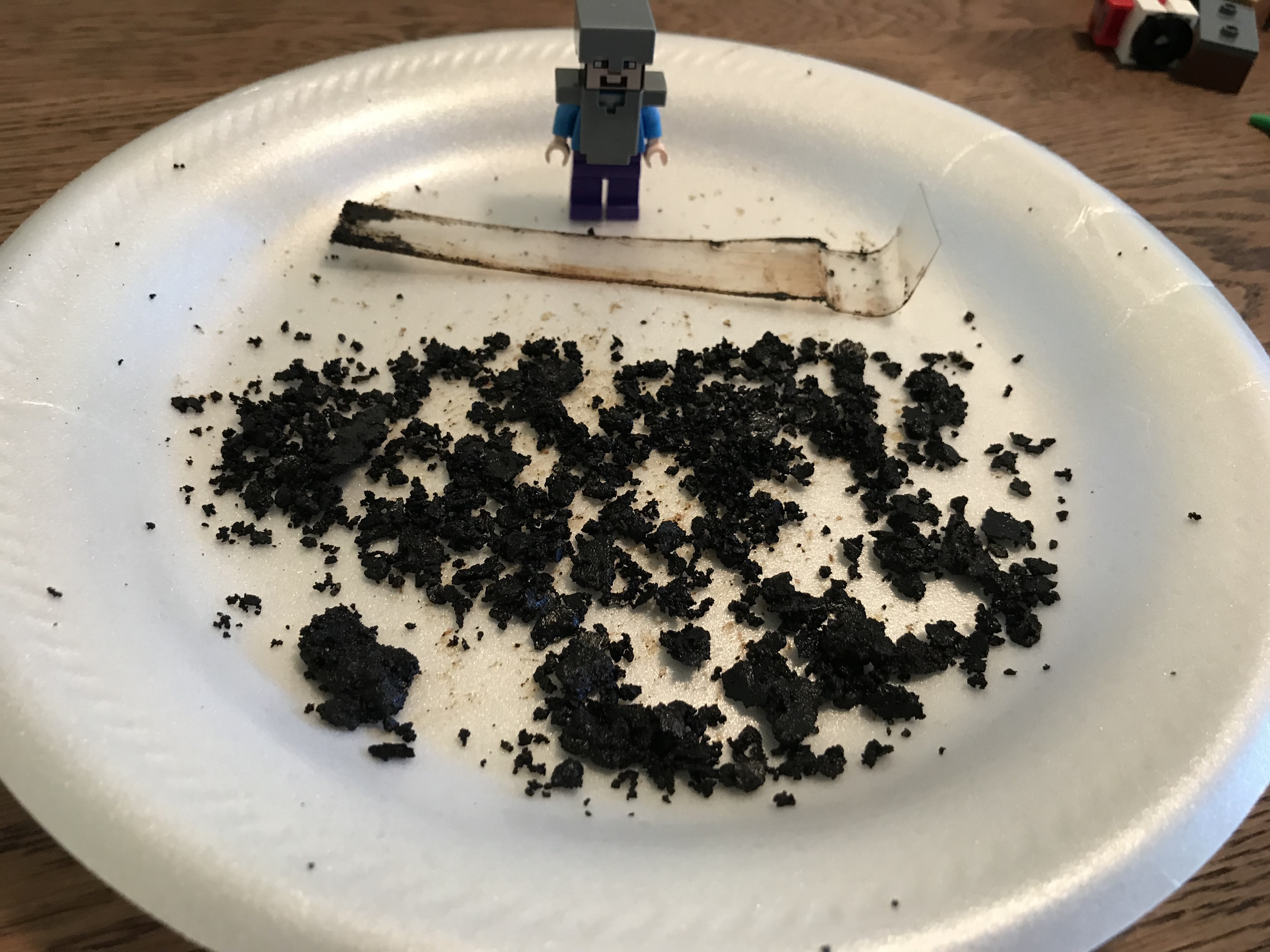
Figure 5
I also discovered some of this residue had gotten behind the holes on the inside of the manifold lodged between the internal orange rubber and the manifold, essentially holding open a constant 2-3 small holes. This explains many of my other improvements I noticed when I finally replaced it. They include:
1) My rough idle issue was finally gone. I could stop without my whole car vibrating.
2) Braking was improved since we use a brake booster utilizing vacuum in our intake manifold.
3) Boost was building past what I was used to at 12.5 psi to over 15 psi due to the new check valve sealing completely to hold the boost.
4) Less oil seeping from oil pan/valve cover/everywhere with a seal due to the increased positive crankcase pressures.
5) MPG.
That’s a lot of things affected by one little tiny rubber piece, am I right? And surprisingly I never had a single check engine light thrown. So as you can see, this check valve is like a ninja engine killer. Seeing all this got me a little worried, so I removed my valve cover to inspect my upper engine, and everything looked fine to me. Boost leak test checked out, and compression test came back 200/195/195/200 first try, so things are looking good for 100k+ miles.
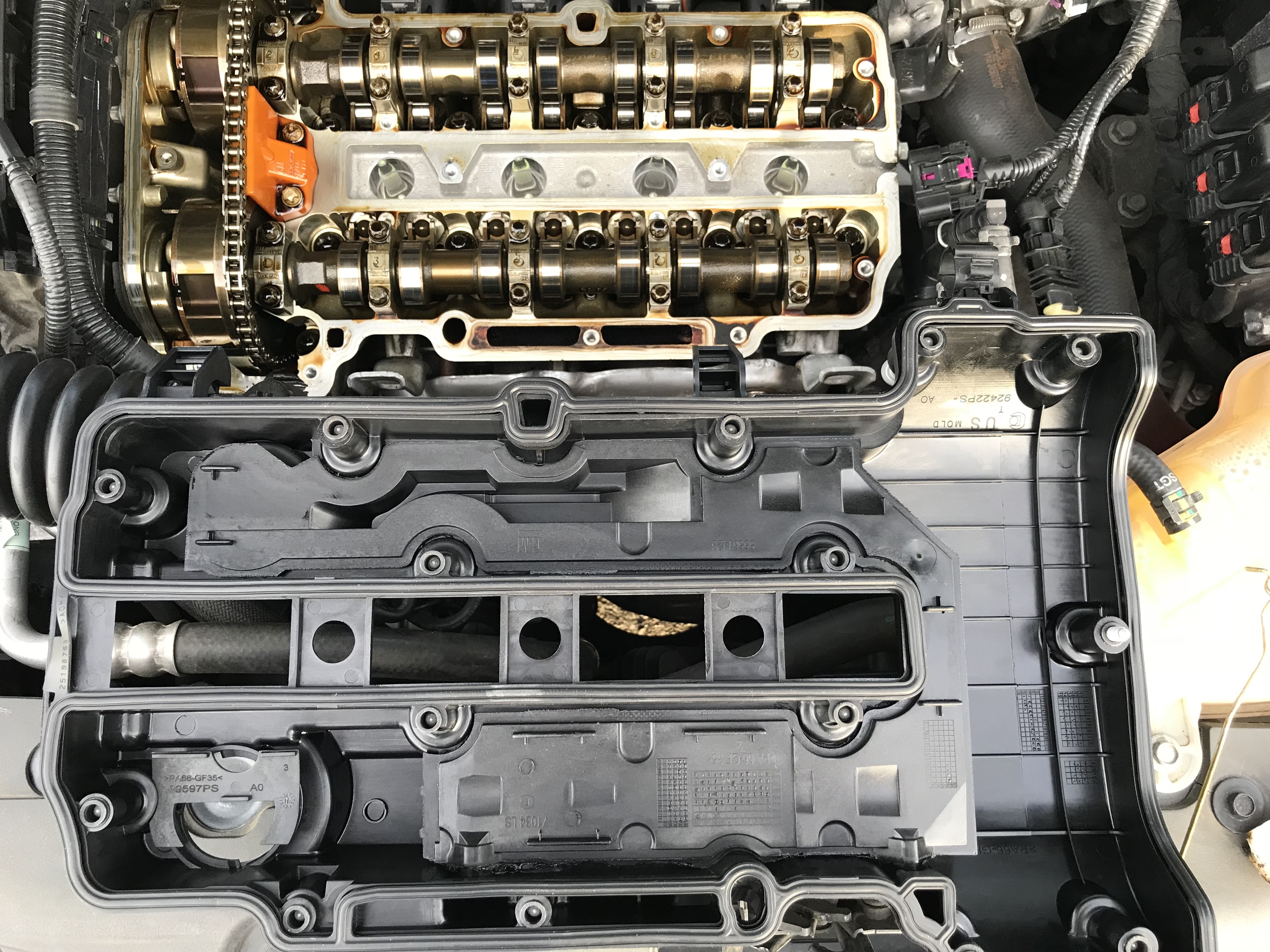
Figure 6
This leads me to believe this is what most peoples intake manifolds may look like after 100k miles. It’s just something that happens with this design and is bound to happen as time goes on according to everything I’m reading and experiencing. One thing to note is the way GM placed the hole that feeds the intake manifolds PCV runner. Any gunk that does come out of the PCV runners from the engine to form in the intake manifold should stay where you see it in figure 4.
This also explains why some are installing oil catch cans between the “Path 2/Boost” hole in Figure 1 and the turbo inlet. If using a tune, I would expect more oil than I experienced on stock tune getting beyond that point. Nonetheless, this was all very rewarding to finally understand and I hope it saves others time in trying to determine their issue.
I attempted to be as accurate and clear as possible, but if I made a mistake somewhere or someone has suggestions to improve this post, please PM me or mention it here. I’m still learning and don’t claim to be an expert.
I bought a brand new sonic 1.4L turbo in 2013 and over the last 5 years/100k miles I developed oil residue inside my intake manifold to the point it caused all kinds of minor issues (which I didn’t realize at the time) with my car. The most upfront and noticeable issue I wanted to diagnose was a rough idle while stopped. In googling and researching my issues I ended up on a few PCV related threads, with a great one on CruzeTalk and one here on SOF by our own Preloader.
BUT, scattered throughout the forums are PCV related questions/issues that either don’t get the answer or get a veteran forum member that mentions checking the intake manifold check valve issue and the new user who just joined for help has no clue what they are talking about, although a starting point. I realized there is a major lack of a “Hey new sonic user, be aware of this PCV issue with your car” thread anywhere obvious here on SOF. So my goal here is to centralize this information for both SOF members and readers who end up here from researching their own issues, and also provide a place for discussion.
1.4L PCV system explained:
I’ll start with the obvious. PCV stands for Positive Crankcase Ventilation. An excellent breakdown on what that is and how it relates to our particular engine can be found in Preloaders thread here: http://www.sonicownersforum.com/forum/1-4l-turbo-sonic-engine-discussion/10825-1-4t-pcv-explained.html. The important thing to take away from that thread is that our 1.4L turbo engines have a closed loop PCV system with two paths:
1) A path when the engine is at idle/vacuum
2) A path for when the system is WOT/utilizing the turbo(boost)
In Figure 1 below you are looking at a close up of this problematic check valve inside the intake manifold which has a 11/32” nut next to it for scale. When entering path two it also passes a second less problematic check valve at the turbo inlet.
Figure 1
At idle PCV gases flow through the tiny holes at the orange check valve, and at WOT that check valve snaps shut and the gases travel up through the hole above which goes to the turbo inlet.
PCV check valve disappearing:
Now that we understand how that check valve is intended to operate we can get into the problems people are experiencing with it. The most prevalent issue is the orange rubber check valve dislodges and gets burned up in the engine, which usually causes the valve cover to fail as well due to the now unmetered pressures through that hole and the car throws under-boost codes and runs like dirt. To verify your check valve is there, it’s as simple as removing the metal retainer on the hose in Figure 2 below and lifting up (located right behind the engine cover on top center of the intake manifold). Looking down that hole is looking down the hole labeled “Path 2/Boost” in Figure 1. You should see the orange nipple of the check valve if it’s still there.

Figure 2
If you don’t see anything it could be dirty, which we’ll get to shortly. If it’s gone you’ll need to replace the whole intake manifold or perform a mod to add an external check valve. A perfect guide on removing the intake manifold can be found here: How-To: Remove 2011-2016 Cruze 1.4L Intake Manifold. Boost on stock vehicles can reach upwards of 13-16 psi. In the instance you completely close the throttle while at that level of psi your engine has a massive shift from positive/boost pressure to negative/vacuum pressure right at that check valve as it opens up, sometimes sucking the whole check valve with it. That’s why tuned engines that run higher boost levels (~20 psi) have a higher chance of this occurring.
PCV check valve getting clogged/dirty:
Now we get to the issue that I’ve personally experienced which can be extremely difficult to diagnose depending on how many miles you get out of your intake manifold’s check valve and how clear it may or may not be to visually see the gunky mess within it. Essentially, with the huge shift in pressures previously mentioned, oil vapors come with it occasionally. Here is what that looks like on my application that made it to 100k miles before causing issues:
Figure 3
As you can see by simply looking down the hole I mentioned in Figure 2, I could see my check valve was extremely caked in oil residue from 5 years/100k miles of use. Honestly, before I started having issues with it I had no reason to check it. Knowing this now, I’ll be cleaning the holes with a Q-tip/rubbing alcohol every oil change, as it only takes 60 seconds to do.
Now although it was clear that particular portion of the intake manifold was pretty dirty, I cleaned the holes of the check valve without resolution to my rough idle. Looking at Figure 4 below you’ll see just how caked the entire PCV runner had gotten:
Figure 4
Clearly, there was just far too much gunk in there. I figured once the holes were uncovered the vacuum would return to normal, and it did to an extent, but was still bad enough that it really just needed replacing. I ended up doing the external PCV mod on an extra used IM I had until I got an entire new manifold, where my issue was finally resolved along with a host of other problems I didn’t realize I was experiencing. Once I replaced my intake manifold and was able to tear apart my other one, I was able to get this much stuff out of my manifold with lego man for scale:
Figure 5
I also discovered some of this residue had gotten behind the holes on the inside of the manifold lodged between the internal orange rubber and the manifold, essentially holding open a constant 2-3 small holes. This explains many of my other improvements I noticed when I finally replaced it. They include:
1) My rough idle issue was finally gone. I could stop without my whole car vibrating.
2) Braking was improved since we use a brake booster utilizing vacuum in our intake manifold.
3) Boost was building past what I was used to at 12.5 psi to over 15 psi due to the new check valve sealing completely to hold the boost.
4) Less oil seeping from oil pan/valve cover/everywhere with a seal due to the increased positive crankcase pressures.
5) MPG.
That’s a lot of things affected by one little tiny rubber piece, am I right? And surprisingly I never had a single check engine light thrown. So as you can see, this check valve is like a ninja engine killer. Seeing all this got me a little worried, so I removed my valve cover to inspect my upper engine, and everything looked fine to me. Boost leak test checked out, and compression test came back 200/195/195/200 first try, so things are looking good for 100k+ miles.
Figure 6
This leads me to believe this is what most peoples intake manifolds may look like after 100k miles. It’s just something that happens with this design and is bound to happen as time goes on according to everything I’m reading and experiencing. One thing to note is the way GM placed the hole that feeds the intake manifolds PCV runner. Any gunk that does come out of the PCV runners from the engine to form in the intake manifold should stay where you see it in figure 4.
This also explains why some are installing oil catch cans between the “Path 2/Boost” hole in Figure 1 and the turbo inlet. If using a tune, I would expect more oil than I experienced on stock tune getting beyond that point. Nonetheless, this was all very rewarding to finally understand and I hope it saves others time in trying to determine their issue.
I attempted to be as accurate and clear as possible, but if I made a mistake somewhere or someone has suggestions to improve this post, please PM me or mention it here. I’m still learning and don’t claim to be an expert.
Last edited:



